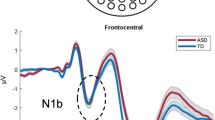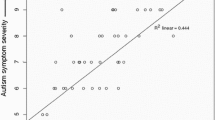Abstract
Three groups of age- and PIQ-matched children (Autism, Receptive Developmental Language Disorder, and normal controls) participated in two eventrelated brain potential (ERP) experiments. Each of these experiments was aimed at evaluating whether either of the two clinical groups of children demonstrated abnormalities in two auditory ERP components, Nl and P2, which are known to be dependent on stimulus characteristics (frequency, intensity, and probability), and believed to be generated within primary and secondary cortex. Results of Experiment 1 provide partial support for the idea that both clinical groups failed to fully process changes in stimulus intensity as indexed by the N1 component. Results are discussed in reference to potential abnormalities in serotonergic regulation of auditory cortex.
Similar content being viewed by others
References
Adams, J., Courchesne, E., Elmasian, R. O., & Lincoln, A. J. (1987). Increased amplitude of the auditory P2 and P3b components in adolescents with developmental dysphasia. In R. Johnson, R. Parassuraman, & J. W. Rohrbaugh (Eds.),Current Trends in Evoked Potential Research (EEG Suppl. 40, pp. 577–583). New York: Elsevier.
Adams, J., Courchesne, E., Elmasian, R., Lincoln, A. J., & Akshoomoff-Haist, N. (1995).Examination of evoked potentials and behavioral performance under varying task demands in nonretarded autistic young adults. Unpublished manuscript.
Adler, G., & Adler, J. (1989). Influence of stimulus intensity in AEP components in the 80- to 200- millisecond latency range.Audiology, 28, 316–324.
Adler, G., & Adler, J. (1991). Auditory stimulus processing at different stimulus intensities as reflected by auditory evoked potentials.Biological Psychiatry, 29, 347–356.
Adler, G., Adler, J., Schneck, M., & Armbruster, B. (1990). Influence of stimulus parameters on auditory stimulus processing in schizophrenia and major depression: an auditory evoked potential study.Acta Psychiatricia Scandinavica, 81, 453–458.
Akshoomoff, N., Courchesne, E., Yeung-Courchesne, R., & Costello, J. (1989). Brainstem auditory evoked potentials in receptive developmental language disorder.Brian and Language, 37, 409–418.
Alho, K., Sainio, K., Sajaniemi, N., Reinikainen, K., & Naatanen, R. (1989). Event-related brain potential of human newborns to pitch change of an acoustic stimulus.
Allen, M., Lincoln, A. J., & Kaufman, A. (1991). Sequential and simultaneous processing abilities of high-functioning autistic children and language impaired children.Journal of Autism and Developmental Disorders, 21, 483–502.
Bruneau, N., Garreau, B., Roux, S., & Lelord, G. (1987). Modulation of auditory evoked potentials with increasing stimulus intensity in autistic children. In R. Johnson, R. Parassuraman, & J. W. Rohrbaugh (Eds.),Current Trends in Evoked Potential Research (EEG Suppl. 40, pp. 584–589). New York: Elsevier.
Courchesne, E. (1978). Neurophysiological correlates of cognitive development: Changes in long-latency event-related potentials from childhood to adulthood.Electroencephalography and Clinical Neurophysiology, 45, 468–482.
Courchesne, E., Courchesne, R. Y., Hicks, G., & Lincoln, A. J. (1985). Functioning of the brain-stem auditory pathway in non-retarded autistic individuals.Electroencephalography and Clinical Neurophysiology, 61, 491–501.
Courchesne, E., Kilman, B. A., Galambos, R., & Lincoln, A. J. (1984). Autism: Processing of novel and auditory information assessed by event-related brain potentials.Electroencephalography and Clinical Neurophysiology, 59, 238–258.
Courchesne, E., Lincoln, A. J., Kolman, B. A., & Galambos, R. (1985). Event-related brain potential correlates of the processing of novel visual and auditory information in autism.Journal of Autism and Developmental Disorders, 15, 55–76.
Courchesne, E., Lincoln, A. J., Yeung-Courchesne, R., Elmasian, R., & Grillon, C. (1989). Pathophysiologic findings in nonretarded autism and receptive developmental language disorder.Journal of Autism and Developmental Disorders, 19, 1–17.
Dawson, G., Finley, C., Phillips, S., Galpert, L., & Lewy, A. (1988). Reduced P3 amplitude of the event-related brain potential: Its relationship to language ability in autism.Journal of Autism and Developmental Disorders, 18, 493–504.
Grillon, C., Courchesne, E., & Akshoomoff, N. (1989). Brainstem and middle latency auditory evoked potentials in autism and developmental language disorder.Journal of Autism and Developmental Disorders, 19, 255–269.
Hegerl, U., & Juckel, G. (1993). Intensity dependence of auditory evoked potentials as an indicator of central serotoneriic neurotransmission: a new hypothesis.Biological Psychiatry, 33, 173–187.
James, A. L., & Barry, R. J. (1980). Respiratory and vascular responses to simple visual stimuli in autistics, retardates and normals.Psychophysiology, 17, 541–547.
Kanner, L. (1943). Autistic disturbances of affective contact.Nervous Child, 2, 217–230.
Lincoln, A. J., Courchesne, E., Harms, L., & Allen, M. (1993). Contextual probability evaluation in autistic, receptive developmental language disorder and control children: ERP evidence.Journal of Autism and Developmental Disorders, 23, 37–58.
Lincoln, A. J., Dickstein, P., Courchesne, E., Elmasian, R., & Tallal, P. (1992). Auditory processing abilities in non-retarded adolescents and young adults with developmental receptive language disorder and autism.Brain and Language, 43, 613–622.
Makela, xxx, & Hari, xxx. (1990). Long latency auditory evoked magnetic fields.Advances in Neurology, 54, 177–191.
Naatanen, R., & Picton, T. W. (1987). The N1 wave of the human electric and magnetic response to sound: a review and an analysis of the component structure.Psychophysiology, 24, 375–425.
Novick, B., Kurtzberg, D., & Vaughan, H. G. (1979). An electrophysiologic indication of defective information storage in childhood autism.Psychiatry Research, 1, 101–108.
Novick, B., Vaughan, H. G., Jr., Kurtzberg, D.,&, Simson, R. (1980). An electrophysiologic indication of auditory processing defects in autism.Psychiatry Research, 3, 107–114.
Oades, R. D., Walker, M. K., Geffen, L. B., & Stern, L. M. (1987). Event-related potentials in autistic and healthy children on an auditory choice reaction time task.International Journal of Psychophysiology, 6, 25–37.
Ornitz, E. (1989). Autism at the interface between sensory and information processing. In G. Dawson (Ed.),Autism: Nature, diagnosis and treatment (pp. 174–207). New York: Guilford.
Picton, T. W., Woods, D. L., & Proulx, G. B. (1978). Human auditory sustained potentials. II. Stimulus relationships.Electroencephalography and Clinical Neurophysiology, 45, 198–210.
Pritchard, W. S., Raz, N., & August, G. J. (1987). Visual augmenting/reducing and P300 in autistic children.Journal of Autism and Developmental Disorders, 17, 231–242.
Schopler, E., Reichler, R., & Renner, B. R. (1988).The Childhood Autism Rating Scale. Los Angeles Western Psychological Services.
Tallal, P., Stark, R., Kallman, C., & Mellits, D. (1981). A reexamination of some nonverbal perceptual abilities of language-impaired and normal children as a function of age and sensory modality.Journal of Speech and Hearing Research, 24, 351–357.
Vaughan, Jr., H. G., & Arezzo, J. C. (1988). The neural basis of the event-related potential. In T. W. Picton (Ed.),Human event-related potentials (EEG Handbook rev. series, Vol. 3, pp. 45–96). Amsterdam: Elsevier.
Wood, C. C., McCarthy, G., Squires, N. K., Vaughan, H. G., Woods, D. L., & McCallum, W. C. (1984). Anatomical and physiological substrates of event-related potentials-two case studies.Annals of the New York Academy of Science, 425, 681–721.
Author information
Authors and Affiliations
Additional information
Supported by NINCDS grant R01-NS26814-02 awarded to Alan Lincoln. The senior author thanks the San Diego Regional Center and the San Diego Unified School District for their continued assistance and support.
Rights and permissions
About this article
Cite this article
Lincoln, A.J., Courchesne, E., Harms, L. et al. Sensory modulation of auditory stimuli in children with Autism And Receptive Developmental Language Disorder: Event-related brain potential evidence. J Autism Dev Disord 25, 521–539 (1995). https://doi.org/10.1007/BF02178298
Issue Date:
DOI: https://doi.org/10.1007/BF02178298




